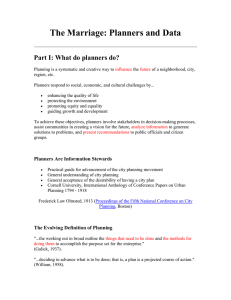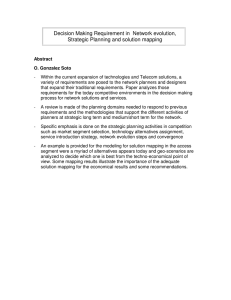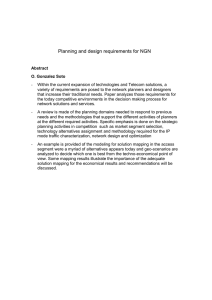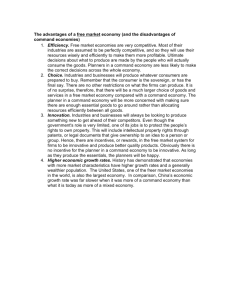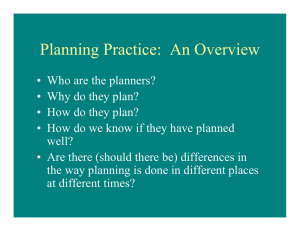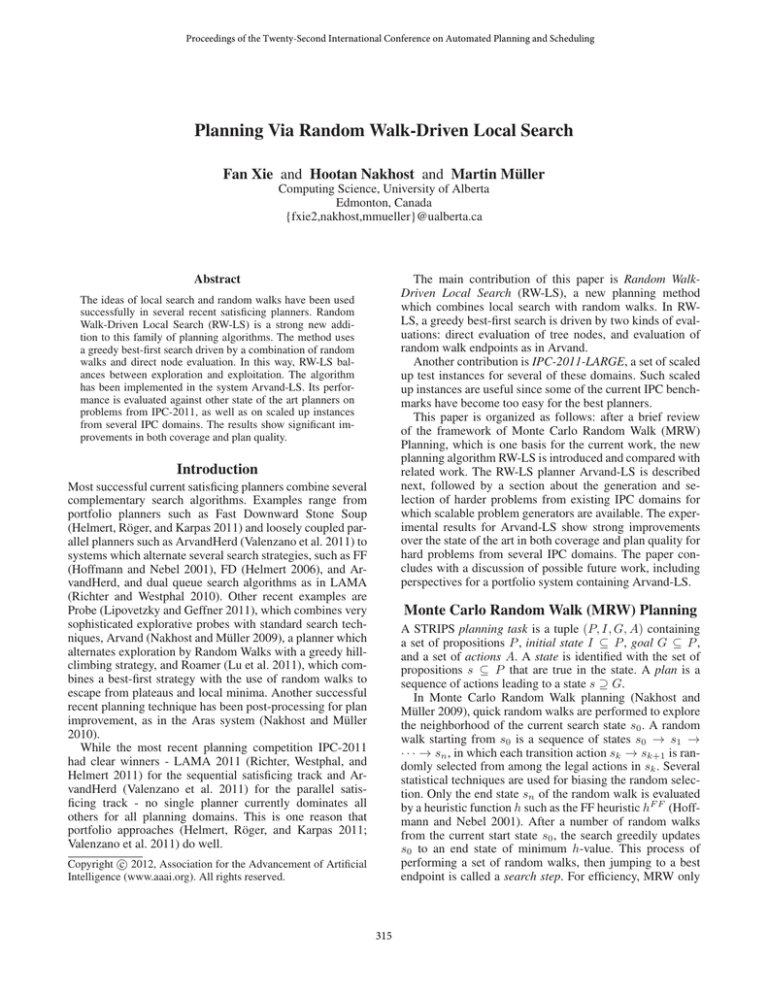
Proceedings of the Twenty-Second International Conference on Automated Planning and Scheduling
Planning Via Random Walk-Driven Local Search
Fan Xie and Hootan Nakhost and Martin Müller
Computing Science, University of Alberta
Edmonton, Canada
{fxie2,nakhost,mmueller}@ualberta.ca
Abstract
The main contribution of this paper is Random WalkDriven Local Search (RW-LS), a new planning method
which combines local search with random walks. In RWLS, a greedy best-first search is driven by two kinds of evaluations: direct evaluation of tree nodes, and evaluation of
random walk endpoints as in Arvand.
Another contribution is IPC-2011-LARGE, a set of scaled
up test instances for several of these domains. Such scaled
up instances are useful since some of the current IPC benchmarks have become too easy for the best planners.
This paper is organized as follows: after a brief review
of the framework of Monte Carlo Random Walk (MRW)
Planning, which is one basis for the current work, the new
planning algorithm RW-LS is introduced and compared with
related work. The RW-LS planner Arvand-LS is described
next, followed by a section about the generation and selection of harder problems from existing IPC domains for
which scalable problem generators are available. The experimental results for Arvand-LS show strong improvements
over the state of the art in both coverage and plan quality for
hard problems from several IPC domains. The paper concludes with a discussion of possible future work, including
perspectives for a portfolio system containing Arvand-LS.
The ideas of local search and random walks have been used
successfully in several recent satisficing planners. Random
Walk-Driven Local Search (RW-LS) is a strong new addition to this family of planning algorithms. The method uses
a greedy best-first search driven by a combination of random
walks and direct node evaluation. In this way, RW-LS balances between exploration and exploitation. The algorithm
has been implemented in the system Arvand-LS. Its performance is evaluated against other state of the art planners on
problems from IPC-2011, as well as on scaled up instances
from several IPC domains. The results show significant improvements in both coverage and plan quality.
Introduction
Most successful current satisficing planners combine several
complementary search algorithms. Examples range from
portfolio planners such as Fast Downward Stone Soup
(Helmert, Röger, and Karpas 2011) and loosely coupled parallel planners such as ArvandHerd (Valenzano et al. 2011) to
systems which alternate several search strategies, such as FF
(Hoffmann and Nebel 2001), FD (Helmert 2006), and ArvandHerd, and dual queue search algorithms as in LAMA
(Richter and Westphal 2010). Other recent examples are
Probe (Lipovetzky and Geffner 2011), which combines very
sophisticated explorative probes with standard search techniques, Arvand (Nakhost and Müller 2009), a planner which
alternates exploration by Random Walks with a greedy hillclimbing strategy, and Roamer (Lu et al. 2011), which combines a best-first strategy with the use of random walks to
escape from plateaus and local minima. Another successful
recent planning technique has been post-processing for plan
improvement, as in the Aras system (Nakhost and Müller
2010).
While the most recent planning competition IPC-2011
had clear winners - LAMA 2011 (Richter, Westphal, and
Helmert 2011) for the sequential satisficing track and ArvandHerd (Valenzano et al. 2011) for the parallel satisficing track - no single planner currently dominates all
others for all planning domains. This is one reason that
portfolio approaches (Helmert, Röger, and Karpas 2011;
Valenzano et al. 2011) do well.
Monte Carlo Random Walk (MRW) Planning
A STRIPS planning task is a tuple (P, I, G, A) containing
a set of propositions P , initial state I ⊆ P , goal G ⊆ P ,
and a set of actions A. A state is identified with the set of
propositions s ⊆ P that are true in the state. A plan is a
sequence of actions leading to a state s ⊇ G.
In Monte Carlo Random Walk planning (Nakhost and
Müller 2009), quick random walks are performed to explore
the neighborhood of the current search state s0 . A random
walk starting from s0 is a sequence of states s0 → s1 →
· · · → sn , in which each transition action sk → sk+1 is randomly selected from among the legal actions in sk . Several
statistical techniques are used for biasing the random selection. Only the end state sn of the random walk is evaluated
by a heuristic function h such as the FF heuristic hF F (Hoffmann and Nebel 2001). After a number of random walks
from the current start state s0 , the search greedily updates
s0 to an end state of minimum h-value. This process of
performing a set of random walks, then jumping to a best
endpoint is called a search step. For efficiency, MRW only
c 2012, Association for the Advancement of Artificial
Copyright Intelligence (www.aaai.org). All rights reserved.
315
evaluates end states of random walks. Computing a heuristic
such as hF F is usually orders of magnitude more expensive
than generating and executing a random action. Therefore,
MRW can afford to explore a much larger neighborhood of
the current search state than the more systematic searches in
planners such as LAMA and FF. MRW iterates until either
a goal state is reached, or it restarts from the initial state I.
Restarts are scheduled when the minimum h-value doesn’t
change for a given number of search steps, or when all random walks from a state reach a dead end.
Monte Carlo Random Walks Local Greedy
Best-First Search
The MRW algorithm emphasizes fast exploration by random walks, while leaving plan improvement to a postprocessor such as Aras. In contrast, RW-LS focuses on plan quality during search by performing a local Greedy Best First
Search in each step. Figure 1 compares the search strategies
of MRW and RW-LS. Both algorithms use random walks to
explore the search space near a starting point s0 . After each
exploration phase, both algorithms update s0 to an explored
state with minimum h-value and start the next search step
from this new s0 . Unlike MRW, RW-LS performs a local
Greedy Best-First Search starting from state s0 during exploration. The search uses well-known enhancements such
as delayed evaluation and a second open list containing only
states reached via preferred operators (Helmert 2006). RWLS evaluates the best state s retrieved from an open list, and
also performs a random walk starting from s ending in a state
r. A linear combination of the heuristic values h(s) and h(r)
is used to order the nodes in the open list.
Figure 1: The search strategies of MRW (left) and RW-LS
(right).
Algorithm 1 The MRW-like main loop of RW-LS
Input Initial State I and goal condition G
Output A solution plan
(s, hmin ) ← (I, h(I))
while G 6⊆ s do
(s, status) ← IteratedRW-LS(s, G)
if status = NO_PROGRESS or DeadEnd(s) then
(s, hmin ) ← (I, h(I)) {restart from initial state}
else
hmin ← h(s)
end if
end while
return the plan from I to s
Algorithm 1 shows an outline of the MRW framework (Nakhost and Müller 2009), adapted to RW-LS. The
only difference in the top-level algorithm is the call to
IteratedRW-LS instead of doing pure exploration by random
walks. A successful search returns the sequence s0 → s1 →
· · · → sn of states along a plan, with s0 = I the initial
state, sn ⊇ G a goal state and the partial paths sk → sk+1
obtained by search steps starting from sk . The main search
loop fails if IteratedRW-LS reports no progress, or if the current search state becomes a dead end. In these cases, the algorithm simply restarts from the initial state I.
Algorithm 2 Iterated RW-LS
Input State s and goal condition G
Parameter MAXSTEPS
Output New s and progress status
open ← [s]
closed ← []
for i = 1 to MAXSTEPS do
s0 ← RW-LS(s, G, open, closed )
if s0 =
6 DEAD_END and h(s0 ) < h(s) then
return (s0 , PROGRESS)
end if
end for
return (s, NO_PROGRESS)
IteratedRW-LS, shown in Algorithm 2, attempts to find
an improved state s0 by calling RW-LS a limited number
of times. Each call constitutes one search step. If the minimum h-value does not improve, IteratedRW-LS returns no
progress.
Unlike MRW, RW-LS performs a random walkguided greedy best-first search as its search step. This
method is shown in Algorithm 3. In the algorithm,
RandomWalk (s, G) performs one random walk from a
state s. As in (Nakhost and Müller 2009), each random walk
either returns the end state r reached after a given maximum
number of random actions, or terminates early on encountering a goal or dead end.
Random Walk-Driven Local Search
Algorithm 3 shows the random walk-guided greedy bestfirst search algorithm. Open and closed lists are shared between iterations. RW-LS performs a random walk from each
316
Algorithm 3 RW-LS, random walk-driven local search
Input state s, goal condition G, open, closed
Parameter NUMWALKS
Output Best state smin or DEAD_END
linear combination of h(s) and h(r) to guide the greedy
best-first search.
Random-Walk Assisted Best-First Search (RWA-BFS)
(Lu et al. 2011) is more closely related to RW-LS, as it combines best-first search with random walks. However, random walks in RWA-BFS are added to a global, complete
best-first search. In contrast, RW-LS is a stochastic local
search algorithm. As a complete global search algorithm,
RWA-BFS outperforms RW-LS in domains which seem to
require some exhaustive search, such as Sokoban and Parking. RW-LS shines in solving large problems for which its
combination of local search and exploration are effective.
Furthermore, while RW-LS runs random walks from every
expanded node, RWA-BFS uses them only when the search
is considered to be stuck in a local minimum.
(smin , hmin ) ← (s, h(s))
for i = 1 to NUMWALKS do
if open.empty() then
return DEAD_END
end if
s ← open.remove_min() {best open node in tree}
if G ⊆ s then
return s
end if
r ← RandomWalk (s, G)
if G ⊆ r then
return r
end if
if h(s) < min(hmin , h(r)) then
(smin , hmin ) ← (s, h(s))
else if h(r) < hmin then
(smin , hmin ) ← (r, h(r))
end if
closed.insert(s)
open.insert(s.children() - closed, w × h(s) + h(r))
end for
return smin
Arvand-LS: A Simple Planner based on
RW-LS
Arvand-LS is an implementation of the RW-LS algorithm
based on the IPC-2011 version of Arvand (Nakhost et al.
2011), called Arvand-2011 here. As outlined in Algorithm 1,
Arvand-LS replaces the pure exploration by random walks
of Arvand-2011 by RW-LS. For most other parts of the
planner, the Arvand-2011 default settings are used, such as
MAXSTEPS = 7 in Algorithm 1. Arvand-LS first runs
each search step with NUMWALKS = 100 random walks.
For each restart from I, this value is doubled, up to a maximum of 3200. There are two reasons for this doubling strategy: as long as no plan to a goal state is found, larger local
searches help increase the probability to find a solution; after a solution is found, larger searches increase the fraction
of in-tree actions, as opposed to random walk actions, in the
solution, which helps improve plan quality. The weight w in
the combined heuristic function of RW-LS is set to a large
value, w = 100, after some initial experiments on IPC-2011.
h(r) is often used only for tie-breaking, but it seems to be
very successful in that because it makes the search more informed in large plateaus. In our testing, the algorithm was
robust against changes to MAXSTEP in the interval [1..14].
Performance declined slowly for larger values of this parameter.
Many of the details of how random walks of
Arvand-LS are performed are identical to Arvand-2011
(Nakhost et al. 2011). Parameters are expressed as a tuple (len_walk , e_rate, e_period , WalkType) (Nakhost and
Müller 2009). Random walk length scaling is controlled
by an initial walk length of len_walk , an extension rate
of e_rate and an extension period of NUMWALKS ∗
e_period . The choices for WalkType are MHA and
MDA, which use online statistics of helpful actions and
deadend states respectively to bias the action selection in random walks. For example, a configuration of
(1, 2, 0.1, MHA) means that all random walks use the
MHA enhancement, and if hmin does not improve for
NUMWALKS ∗0.1 random walks, then the length of walks,
len_walk , which starts at 1, will be doubled. The three configurations used are:
• config-1: (10, 2, 0.1, MHA)
state retrieved from the open list, and evaluates the endpoint
r. The algorithm keeps track of, and returns the best state
seen overall, either from closed or from a random walk endpoint. States in open are ordered by a linear combination
w × h(s) + h(r). The parameter w controls the trade-off between exploration and exploitation. The variable open in the
algorithm manages both the normal and the preferred operator open lists. The method also keeps track of the path (action sequence) leading from s to the best state smin . In case
smin was a random walk endpoint, this path consists of an
in-tree prefix followed by the random walk. For simplicity,
the details of path handling are omitted in the pseudocode.
If RW-LS fails to find an improvement, it returns the input
state. Unlike Arvand, there is no forced transition to an end
point in this case, and IteratedRW-LS repeatedly calls RWLS from the same start state, while keeping the open and
closed lists and increasing the parameter NUMWALKS.
Comparison to Other Related Algorithms
The RW-LS algorithm has some similarities to Enforced Hill
Climbing (Hoffmann and Nebel 2001). Both algorithms perform a local search before transitioning to the next search
state. The major differences are:
• EHC uses a uniform, breadth first exploration strategy.
RW-LS combines a selective GBFS with random walks
to explore a larger neighborhood.
• EHC does not use heuristic values to guide the search,
until it finds a state with improved h-value. RW-LS uses a
317
• config-2: (1, 2, 0.1, MDA)
L to an upper limit of U in increments of I. For example,
p ∈ [10..30; 5] means that the generated instances have values of p ∈ {10, 15, 20, 25, 30}.
• config-3: (1, 2, 0.1, MHA)
The algorithm cycles through these configurations, starting
with config-1 and changing at each restart.
Integration with the Aras postprocessor is also identical
to Arvand-2011: Aras is run on each new plan found until it reaches the memory limit. Compared to the original
postprocess-once method proposed in (Nakhost and Müller
2010), this applies Aras to a larger variety of input plans.
One major difference between Arvand-2011 and ArvandLS is less pruning: Arvand-LS turns off the pruning in the
search or random walks for states whose cost so far exceeds
the cost of the best found solution. This pruning does not
work well for Arvand-LS since its high quality initial plans
often prevent the algorithm from finding any other alternate
plans. In conjunction with the Aras postprocessor, allowing
greater plan diversity is more important for achieving good
final results than stronger pruning.
Elevators The hardest IPC-2011 problem has f = 40 floors
and p = 60 passengers. The new problems also fix f =
40, and vary p ∈ [20..305; 15].
Openstacks The largest number of products in IPC-2011 is
p = 250. New problems use p ∈ [250..630; 20].
Visit-All The hardest IPC-2011 problem has grid size g =
50. New problems use g ∈ [48..86; 2].
Woodworking The largest number of parts in IPC-2011 is
p = 23. For new problems, p ∈ [25..105; 4].
The new test set is designed to be a clear step up in difficulty from IPC-2011. Only planners that were able to solve
most of the IPC-2011 instances for a given domain are likely
to solve some of the new IPC-2011-LARGE instances.
Experiments
IPC-2011-LARGE: Scaling up IPC-2011
Domains
Experiments include tests on all IPC-2011 and IPC-2011LARGE benchmarks. They were run on an 8 core 2.8 GHz
machine with a time limit of 30 minutes and memory limit
of 2 GB per problem. Results for planners which use randomization are averaged over 5 runs.
In several domains, the test instances used at IPC-2011 have
become too easy for the current top planners. Harder instances are needed to show that a new approach advances the
state of the art in coverage as well as in plan quality. The collection IPC-2011-LARGE, available at http://code.google.
com/p/ipc2011-large-domain, represents a new, more challenging test set.
Four out of fourteen IPC-2011 domains have been scaled
up to harder problems in IPC-2011-LARGE to help illustrate
the performance of Arvand-LS: Woodworking, Openstacks,
Elevators and Visit-All. Regarding the other IPC-2011 domains, Transport, Tidybot, Nomystery and Floortile seem
hard enough for current planners, so scaling can wait. In
Parking, Sokoban and Barman, neither Arvand nor ArvandLS scale very well - see the discussion in the IPC-2011 results section below. Depending on the needs of the community, IPC-2011-LARGE could be expanded in the future
to include harder instances from those domains. For the remaining domains of Parcprinter, Pegsol and Scanalyzer, no
scalable generators were available.
In Woodworking, wood must be processed using different tools to produce parts. Planners should minimize the
processing cost. Openstacks is a combinatorial optimization
problem where products must be temporarily stacked. Planners need to minimize the maximum number of stacks in
simultaneous use. In Elevators, passengers need to be transported using two types of elevators with different cost characteristics. In Visit-All, an agent located in the center of a
n × n grid must visit all cells of the grid while minimizing
the number of moves.
Planners and Evaluation
The experiments compare Arvand-LS with the best known
version of seven other planners: three top performers from
IPC-2011, LAMA-2011, FDSS-2 and Probe; the random
walk-based planner Arvand; the well-known local search
planner LPG-td (Gerevini, Saetti, and Serina 2003); FF
and FD-Autotune-2 (FD-AT-2), which both use Enforced
Hill Climbing as the first try to solve the problem – while
FF is not tuned to generate high-quality solutions, FDAT-2, after finding the first solution runs WA* to improve
the quality; and Roamer, which is included for comparison with Random-Walk Assisted Best-First Search. LAMA2011-FF is LAMA-2011 in FF-only mode, with the Landmark Heuristic disabled. Since Arvand and Arvand-LS use
FF only, this version of LAMA-2011 helps to make a better
comparison by isolating the influence of of the LM heuristic.
The IPC-2011 versions of Roamer and Arvand were affected by a bug in the PDDL-to-SAS+ translator used. Arvand also had a memory management problem. These issues
have been fixed in the versions of the planners used in the
current experiments.
The evaluation method is the same as in IPC-2011: the
score for an unsolved problem is 0. For each solved problem,
the planner receives a score between 0 and 1, scaled relative
to the best plan.
IPC-2011-LARGE Parameter Settings
Results on IPC-2011 Benchmarks
Parameters used in most IPC-2011-LARGE instances are
larger than the hardest problems in IPC-2011. To describe
a range of parameters, the notation p ∈ [L..U ; I] is used
to indicate that parameter p varies from a lower limit of
The coverage and quality results on IPC-2011 are shown in
Tables 1 and 2. In addition, Figure 2 plots the number of
problems solved for the first 5 minutes and for the full 30
minutes. Arvand-LS solves more problems quickly than the
318
• Arvand-LS significantly outperforms the other tested
planners in all domains except Large-Openstacks, where
Arvand has a slight advantage. Arvand-LS solves twice as
many problems as LAMA-2011, the winner of IPC-2011.
Many other planners have problems scaling up to these
large instances.
• Both RW-LS and MRW scale better than EHC implemented both in FF and FD-AT-2.
• Relying on random walks to escape from the plateaus
in a global best-first search framework is not enough to
scale to these large problems: both Arvand and ArvandLS solve between 5 to 20 problems more than Roamer in
each of the domains.
• In three out of four domains, the local search in ArvandLS increases coverage compared to Arvand.
other tested planners. The overall performance of ArvandLS shows a significant improvement compared to the baseline planner Arvand and exceeds that of several other top
planners.
The coverage of both Arvand and Arvand-LS is weak in
the domains of Sokoban, Parking and Barman. The main
reason for the bad performance of random walks in these
domains is that specific action sequences need to be discovered in order to make progress. The probability of repeatedly discovering such sequences through random walks is
very small. In contrast, best-first search planners work much
better in these domains, since they store the states that they
have already tried, and can discover such paths by a complete search. The local search in Arvand-LS improves upon
Arvand’s pure exploration: The average Sokoban coverage
improves from 2.2 to 8.4, Parking improves from 3.8 to 8.6
and Barman from 0 to 9.6.
Another interesting data point shown is LAMA-2011-FF,
the version of LAMA without the LM heuristic. It solves
39 fewer problems than LAMA-2011. Visit-All shows the
biggest drop, from 20 to 4. This domain is also very hard for
many other planners that don’t use the LM heuristic, such as
FD-AT-2 and FDSS-2. Interestingly, the random walks planners Arvand and Arvand-LS, which use only the FF heuristic, solve all problems in Visit-All. These question remain as
future work: why do random walks perform well in VisitAll? And can adding the LM heuristic improve Arvand and
Arvand-LS?
While local search improves the coverage of random walk
planners most of the time, it fails for Nomystery (Nakhost,
Hoffmann, and Müller 2012). This is a truck-package transportation domain similar to Transport in IPC-2011. Its
key feature is that trucks only have a limited amount of
fuel. In such resource constrained planning domains, deleterelaxation heuristics are not informative, since they ignore
resource consumption. Random walk-based methods work
very well here (Nakhost, Hoffmann, and Müller 2012). In
Arvand-LS, the local greedy best first search guided by the
FF heuristic seems to suffer from similar problems as other
GBFS planners, following paths of great heuristic improvement but running out of fuel in the process. While ArvandLS is weaker than Arvand here because of its greedy bestfirst search, thanks to random walks, it still achieves the third
best score among all tested planners.
Compared to Arvand, Arvand-LS shows a significant improvement on plan quality in Elevator, Openstacks, Scanalyzer and Visit-All. In these domains, the local search finds
much shorter plans. In Elevator, the plan quality of ArvandLS is even better than that achieved with systematic search
planners.
Arvand-LS ties with at least one other planner in solving all the tasks in 7 out of 14 domains. To be able to
make meaningful comparisons on these domains, harder instances were created for domains where scalable generators
are available.
Figure 3 shows IPC-style scores for each domain. To keep
the figures readable, only the results of the four planners
with highest score are shown in each domain 1 . The results
show:
• Arvand-LS always generates better quality plans compared to Arvand. In a few cases such as problems 17-20
in Large-Openstacks, Arvand-LS gets lower scores since
it is not able to consistently solve the problem in all 5
runs.
• Except for Large-Visit-All, Arvand-LS creates plans of
better (Large-Elevators) or competitive quality compared
to more systematic planners such as LAMA-2011.
Focusing on the Large-Elevators results in Figure 3(a),
the difference in plan quality of Arvand-LS and Arvand decreases with problem size. There are two reasons for this:
For problems 10 to 20, solutions are found only by the
config-1 configuration using long random walks, so the generated solutions consist mostly of random actions. Furthermore, these solutions are so long that Aras has memory
problems. The best solution for problem 1 is found by FDAutotune-2. However, this planner did not scale to larger instances.
In Large-Openstacks, Figure 3(b), both LAMA-2011 and
Arvand-LS generate good quality solutions initially, but
Arvand-LS scales better. Arvand-LS finds better quality solutions than Arvand until problem 16, and then Arvand takes
over for larger instances. Beyond problem 16, Arvand-LS
does not solve the problems in all 5 trial runs.
For smaller Large-Visit-All instances, both Arvand and
Arvand-LS generate lower quality plans than LAMA. Only
Arvand-LS scales beyond problem 13. To avoid making
bubbles - unvisited squares surrounded by visited squares
- is a good strategy to generate good quality plans in this domain. Random walks visit unvisited squares quickly in the
beginning, but create a lot of bubbles on the way, leading to
bad plan quality.
The Large-Woodworking instances, Figure 3(d), seem relatively easier since more planners can solve problems here.
The plan quality on the first 10 problems is very close for
the tested planners. Only Arvand-LS scales beyond problem
Results on IPC-2011-LARGE Problems
Table 3 shows the coverage of all tested planners on the four
scaled domains. The key observations are:
1
319
In Large-Visit-All, only three planners solve any problem.
Domains
barman(20)
elevators(20)
floortile(20)
nomystery(20)
openstacks(20)
parcprinter(20)
parking(20)
pegsol(20)
scanalyzer(20)
sokoban(20)
tidybot(20)
transport(20)
visitall(20)
woodworking(20)
Total(280)
Arvand-LS Arvand Roamer Probe LAMA-2011 LAMA-2011-FF FD-AT-2 FDSS-2
9.6
0
16.8
20
20
17
4
14
20
20
13.4
20
20
18
16
18
1.2
1.8
1
4
5
4
9
6
14
19
10
7
11
8
16
13
20
20
20
12
20
17
19
14
20
20
7
13
20
20
14
20
8.6
3.8
5
15
15
11
4
19
20
20
19
20
20
20
20
20
20
17.6
20
18
20
20
17
20
8.4
2.2
12.4
15
18
18
15
18
17
17.8
15
18
16
11
16
16
18
14
16
13
14
12
9
13
20
20
18
18
20
4
4
6
20
20
18.6
20
20
20
13
20
216.8 196.2 192.2 213
239
200
176
217
Table 1: Number of tasks solved in IPC-2011. Total number of tasks shown in parentheses after each domain name.
Figure 2: The number problems solved in the first 5 minutes and 30 minutes
13. The low score for problem 17 is due to 3 out of 5 trial
runs of Arvand-LS failing.
To summarize, Arvand-LS is the strongest planner overall
in these tests in terms of both coverage and quality. In some
problems with moderate plan length, Arvand has better performance than Arvand-LS. Because of the post-processing
system Aras, for small problems, the diversity of input plans
for Aras is more important than the quality of initial plans.
Arvand produces more, and also more diverse, plans than
Arvand-LS because of its faster pure exploration strategy.
For larger problems, the very long plans generated by Arvand often deviate too far from good plans, and the local optimization of Aras is not sufficient to substantially improve
these.
quality significantly over the IPC-2011 version of Arvand.
In domains which contain sufficiently many paths from the
initial state to a goal the algorithm scales better than other
state of art planners.
Because of its complimentary strengths compared to planners based on more systematic search, Arvand-LS is a strong
candidate component for inclusion in future portfolio planners.
Another contribution of this paper is motivating the need
for, and providing scaled up test instances from IPC planning domains in form of the IPC-2011-LARGE collection.
Since several of the IPC-2011 test sets have become too easy
for the best planners, the limits of current planning technology on standard domains can be explored only by scaling up
to larger instances.
One remaining weakness of Arvand-LS is in problems
that require exhaustive search of large regions of the state
space, such as Sokoban and Parking. Planners such as
LAMA-2011 and Probe are much stronger in solving those
problems. While a limited local GBFS can escape from
Conclusions and Future Work
The primary contribution of this paper is introducing the
new algorithm RW-LS, which uses a local Greedy Best-First
Search driven by both direct node evaluation and Random
Walks. The planner Arvand-LS improves both coverage and
320
Domains
barman(20)
elevators(20)
floortile(20)
nomystery(20)
openstacks(20)
parcprinter(20)
parking(20)
pegsol(20)
scanalyzer(20)
sokoban(20)
tidybot (20)
transport(20)
visitall (20)
woodworking(20)
Total(280)
Arvand-LS Arvand Roamer
9.56
0.00 14.22
18.79
7.63
9.57
1.20
1.80
0.89
13.16 18.11
9.65
15.25
9.78 17.20
18.56 17.61
6.05
6.63
2.85
3.04
19.96 19.91 17.69
18.94 15.41 16.63
7.89
2.17 12.15
15.01 15.85 12.95
16.26 10.54 13.36
11.51
7.59 17.43
16.36 16.09 11.05
189.08 145.34 161.86
Probe LAMA-2011 LAMA-2011-FF FD-AT-2 FDSS-2
17.98
16.78
14.12
2.55 13.15
7.57
9.20
8.87
13.99 11.76
2.13
4.22
3.42
8.96
5.21
6.79
10.84
7.89
15.61 12.28
10.61
18.59
15.93
18.08 11.94
11.29
19.82
18.34
13.64 18.24
7.32
12.82
6,79
3.84 17.14
18.41
19.90
19.23
19.78 14.46
14.83
17.60
16.59
15.14 17.81
11.83
16.64
17.61
14.92 16.08
16.40
14.04
9.63
13.78 13.19
6.76
11.02
7.10
7.51
7.67
17.57
18.07
1.40
3.35
1.73
17.87
15.26
15.28
9.71 19.14
167.36
204.78
162.21 160.87 179.80
Table 2: Score in IPC-2011. The maximum possible score is shown in parentheses after each domain name.
Domains
large-elevator(20)
large-openstacks (20)
large-visitall(20)
large-woodworking(20)
total(80)
Arvand-LS Arvand Roamer Probe LAMA-2011 FD-AT-2 FDSS-2 FF LPG
20.0
18.8
1.2
4.0
4.0
1.0
2.0 3.0 0.4
16.0
17.6
10.0
0.0
8.0
0.0
0.0 1.0 0.0
20.0
12.6
0.0
0.0
13.0
0.0
0.0 0.0 0.0
18.0
10.4
5
4.0
11.0
3.0
11.0 3.0 8.6
74.0
59.4
16.2
8.0
36.0
4.0
13.0 7.0 9.0
Table 3: Number of tasks solved in IPC-2011-LARGE. Total number of tasks shown in parentheses after each domain name.
small local minima or plateaus with narrow exit points, it
fails for large cases. Some interesting topics for future work
include:
• Build a portfolio planner containing Arvand-LS as well as
other planners such as LAMA and Arvand.
• Add efficient complete global search algorithms such as
Beam-Stack Search (Zhou and Hansen 2005) to the RWLS framework, in order to improve performance in problems where exhaustive search is important.
• Review the generators for more planning domains, for example those used in previous competitions, and identify
further domains that can also be scaled up and added to
the collection of large problems.
• Study the scaling behavior of current planners under other
parameters such as increased memory and time.
Helmert, M. 2006. The Fast Downward planning system.
Journal of Artificial Intelligence Research 26:191–246.
Hoffmann, J., and Nebel, B. 2001. The FF planning system:
Fast plan generation through heuristic search. Journal of
Artificial Intelligence Research 14:253–302.
Lipovetzky, N., and Geffner, H. 2011. Searching for
plans with carefully designed probes. In Proceedings of the
Twenty-First International Conference on Automated Planning and Scheduling (ICAPS-2011), 154–161.
Lu, Q.; Xu, Y.; Huang, R.; and Chen, Y. 2011. The Roamer
planner random-walk assisted best-first search. In GarcíaOlaya et al. (2011), 73–76.
Nakhost, H., and Müller, M. 2009. Monte-Carlo exploration for deterministic planning. In Proceedings of the
Twenty-First International Joint Conference on Artificial Intelligence (IJCAI’09), 1766–1771.
Nakhost, H., and Müller, M. 2010. Action elimination
and plan neighborhood graph search: Two algorithms for
plan improvement. In Brafman, R.; Geffner, H.; Hoffmann,
J.; and Kautz, H., eds., Proceeedings of the 20th International Conference on Automated Planning and Scheduling
(ICAPS-2010), 121–128. Toronto, Canada: AAAI Press.
Nakhost, H.; Müller, M.; Valenzano, R.; and Xie, F. 2011.
Arvand: the art of random walks. In García-Olaya et al.
(2011), 15–16.
Nakhost, H.; Hoffmann, J.; and Müller, M. 2012. Resourceconstrained planning: A Monte Carlo random walk ap-
References
García-Olaya, A.; Jiménez, S.; and Linares López, C., eds.
2011. The 2011 International Planning Competition. Universidad Carlos III de Madrid.
Gerevini, A.; Saetti, A.; and Serina, I. 2003. Planning
through stochastic local search and temporal action graphs
in LPG. J. Artif. Intell. Res. (JAIR) 20:239–290.
Helmert, M.; Röger, G.; and Karpas, E. 2011. Fast Downward Stone Soup: A baseline for building planner portfolios.
In Proceedings of the ICAPS-2011 Workshop on Planning
and Learning (PAL), 28–35.
321
(a) IPC-2011-Large-Elevators
(b) IPC-2011-Large-Openstacks
(c) IPC-2011-Large-Visit-All
(d) IPC-2011-Large-Woodworking
Figure 3: Scores of top four planners on IPC-2011-LARGE. The x-axis presents the problem numbers. The size of problems
grows from problem 1 to problem 20.
proach. In Proceeedings of the Twenty-Second International Conference on Automated Planning and Scheduling
(ICAPS-2012).
Richter, S., and Westphal, M. 2010. The LAMA planner:
Guiding cost-based anytime planning with landmarks. Journal of Artificial Intelligence Research 39:127–177.
Richter, S.; Westphal, M.; and Helmert, M. 2011. LAMA
2008 and 2011. In García-Olaya et al. (2011), 50–54.
Valenzano, R.; Nakhost, H.; Müller, M.; Schaeffer, J.; and
Sturtevant, N. 2011. ArvandHerd: Parallel planning with a
portfolio. In García-Olaya et al. (2011), 113–116.
Zhou, R., and Hansen, E. 2005. Beam-stack search: Integrating backtracking with beam search. In Proceedings of
the Fifteenth International Conference on Automated Planning and Scheduling (ICPAS-2005), 90–98.
322

